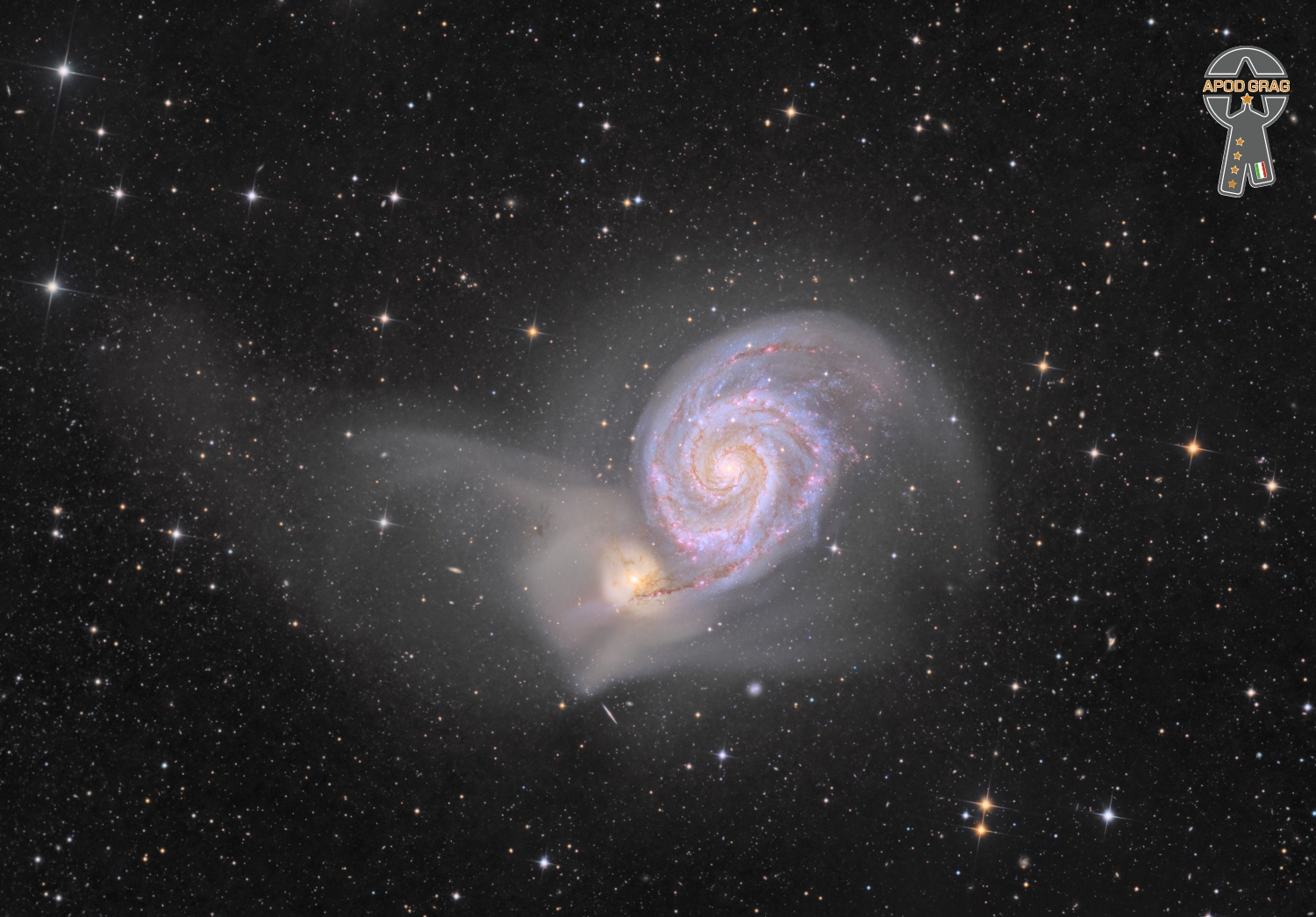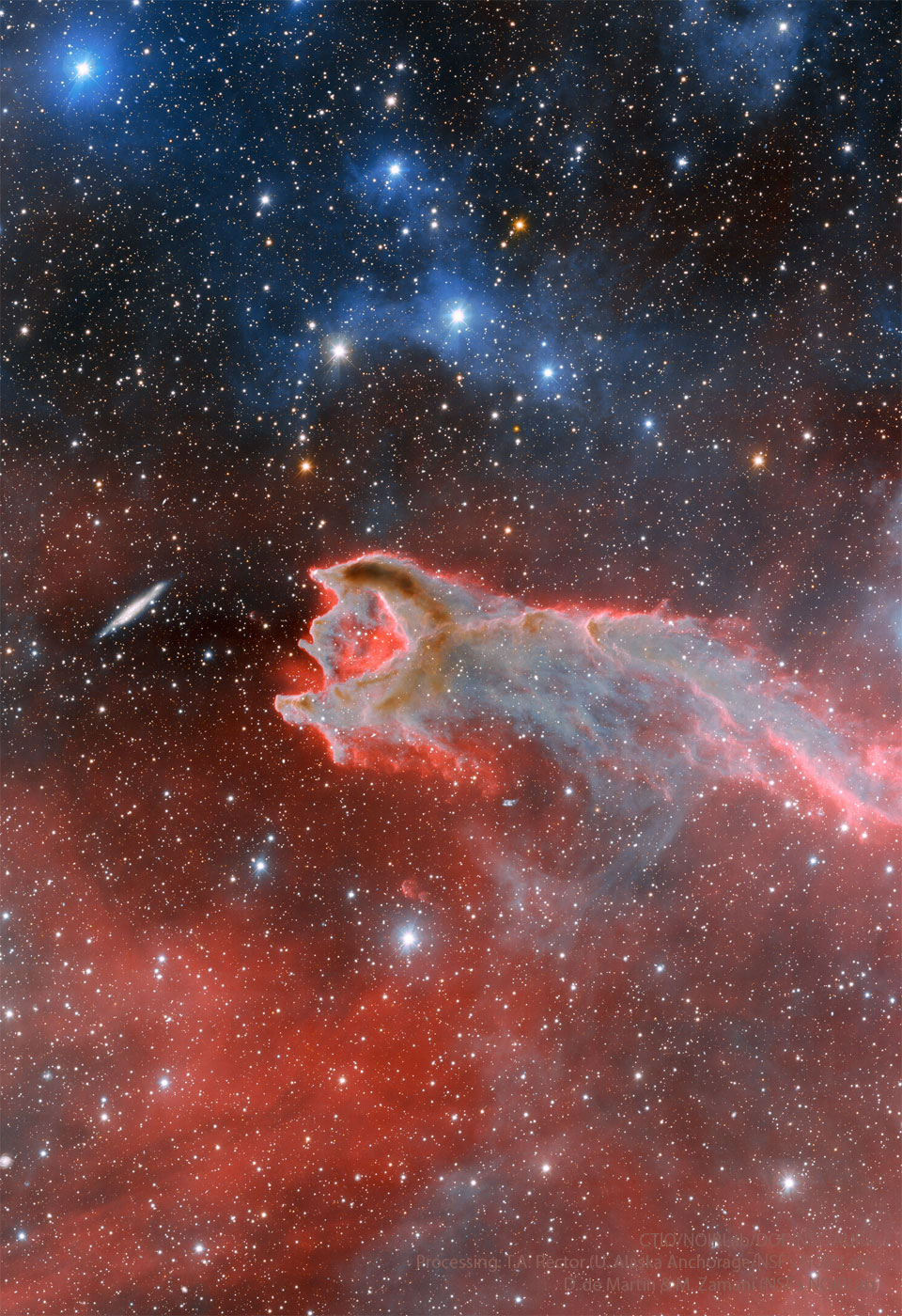Blog

Rhythm Roots Workshop Residency Ecumen Lakeview Commons Assisted Living and Memory Care in Maplewood

The Whirlpool Galaxy, also known as Messier 51a (M51a) or NGC 5194, is an interacting grand-design spiral galaxy with a Seyfert 2 active galactic nucleus. It lies in the constellation Canes Venatici, and was the first galaxy to be classified as a spiral galaxy. It is 7.22 megaparsecs (23.5 million light-years) away and 23.58 kiloparsecs (76,900 ly) in diameter.
The galaxy and its companion, NGC 5195, are easily observed by amateur astronomers, and the two galaxies may be seen with binoculars. The Whirlpool Galaxy has been extensively observed by professional astronomers, who study it and its pair with NGC 5195 to understand galaxy structure (particularly structure associated with the spiral arms) and galaxy interactions. Its pair with NGC 5195is among the most famous and relatively close interacting systems, and thus is a favorite subject of galaxy interaction models.

Wilhelm Richard Wagner (/ˈvɑːɡnər/ VAHG-nər; German: [ˈʁɪçaʁt ˈvaːɡnɐ] 22 May 1813 – 13 February 1883) was a German composer, theatre director, polemicist, and conductor who is chiefly known for his operas (or, as some of his mature works were later known, “music dramas”). Unlike most opera composers, Wagner wrote both the libretto and the music for each of his stage works. Initially establishing his reputation as a composer of works in the romantic vein of Carl Maria von Weber and Giacomo Meyerbeer, Wagner revolutionised opera through his concept of the Gesamtkunstwerk (“total work of art”), by which he sought to synthesise the poetic, visual, musical and dramatic arts, with music subsidiary to drama. He described this vision in a series of essays published between 1849 and 1852. Wagner realised these ideas most fully in the first half of the four-opera cycle Der Ring des Nibelungen (The Ring of the Nibelung).
His compositions, particularly those of his later period, are notable for their complex textures, rich harmonies and orchestration, and the elaborate use of leitmotifs—musical phrases associated with individual characters, places, ideas, or plot elements. His advances in musical language, such as extreme chromaticism and quickly shifting tonal centres, greatly influenced the development of classical music. His Tristan und Isolde is sometimes described as marking the start of modern music.
Wagner had his own opera house built, the Bayreuth Festspielhaus, which embodied many novel design features. The Ring and Parsifal were premiered here and his most important stage works continue to be performed at the annual Bayreuth Festival, which was galvanized by the efforts of his wife Cosima Wagnerand the family’s descendants. His thoughts on the relative contributions of music and drama in opera were to change again, and he reintroduced some traditional forms into his last few stage works, including Die Meistersinger von Nürnberg (The Mastersingers of Nuremberg).
Until his final years, Wagner’s life was characterised by political exile, turbulent love affairs, poverty and repeated flight from his creditors. His controversial writings on music, drama and politics have attracted extensive comment – particularly since the late 20th century, as they express antisemitic sentiments. The effect of his ideas can be traced in many of the arts throughout the 20th century; his influence spread beyond composition into conducting, philosophy, literature, the visual arts and theatre.
more...Ian Robertson Underwood (born May 22, 1939) is a woodwind and keyboards player, known as a member of the original version of Frank Zappa‘s band the Mothers of Invention. Following the original band’s split in late 1969, Underwood continued to work with Zappa extensively during the 1970s.
Underwood graduated from The Choate School in 1957 and Yale University with a bachelor’s degree in composition in 1961 and a master’s degree in composition at UC Berkeley in 1966. He began his career by playing San Francisco Bay Area coffeehouses and bars with his improvisational group, the Jazz Mice, in the mid-1960s before he became a member of Frank Zappa and the Mothers of Invention in 1967 for their third studio album, We’re Only in It for the Money. He speaks on Uncle Meat; on the track “Ian Underwood Whips It Out” he relates how he first met Zappa and demonstrated his capabilities on the saxophone at Zappa’s invitation. Underwood later worked with Frank Zappa on his solo recordings, including 1969’s Hot Rats. He married Ruth Komanoff(Underwood), marimbist/percussionist from the Mothers of Invention in May 1969. Underwood left the Mothers of Invention in September 1973. He and Ruth divorced in 1986.
After his association with Frank Zappa, he pursued a career as a session keyboardist. Underwood has since been proficient on the Minimoog synthesizer, mostly in film. He has been credited in recordings for Quincy Jones, Barbra Streisand, Ronee Blakley, Hugh Cornwell, Freddie Hubbard, Jean-Luc Ponty, Herb Alpert, Hugh Masekela, Peggy Lee, Dolly Parton, Chicago, Janet Jackson, Dave Grusin, Jefferson Airplane, Frankie Valli, the Carpenters, James Ingram, and Barry Manilow. Underwood was also one of the musicians who played the main title theme for the 1980s hit series Knight Rider. Underwood was the uncredited producer of the debut album by Alice Cooper, Pretties For You, in 1969.
more...Barron W. “Barry” Rogers (May 22, 1935 – April 18, 1991) was an American jazz and salsa trombonist.
Born in The Bronx, he descended from Polish Jews and was raised in Spanish Harlem. His family (original name: Rogenstein) possessed a strong musicality. His father and several of his uncles sang in the choir of Joseph Rosenblatt, and his mother taught in Africa and Mexico, inspiring an interest in music from other nations. Mambo and jazz popular in his neighbourhood.
As a student of the playing of jazz trombonists Jack Teagarden, Lawrence Brown, and J. C. Higginbotham, Rogers began to play Latin music in the mid-1950s and would be most associated with it from then on. He developed his style while working with Eddie Palmieri. Willie Colón regarded Rogers as his strongest musical influence and would feature him in many of his productions. Bobby Valentín would feature Rogers in his song “El Jíbaro y la Naturaleza”, which led Marvin Santiago to nickname him “El Terror de los Trombones” for the record.
Rogers worked with Israel “Cachao” López, Machito, Manny Oquendo, Celia Cruz, Tito Puente, Cheo Feliciano, Johnny Pacheco, Chino Rodríguez, and the Fania All-Stars. Although known as a salsa trombonist and studio musician, he worked with jazz, soul, and pop musicians. He was a founding member of the band Dreams with Michael Brecker, Randy Brecker, and Billy Cobham. He also worked with George Benson, David Byrne, Ron Carter, Aretha Franklin, Don Grolnick, Bob James, Elton John, Chaka Khan, Bob Moses, Todd Rundgren, Carly Simon, Spyro Gyra, James Taylor, and Grover Washington Jr. The father of trumpeter Chris Rogers, Barry Rogers died suddenly in Washington Heights, Manhattan at the age of 55.
more...Le Sony’r Ra (born Herman Poole Blount, May 22, 1914 – May 30, 1993 Birmingham, AL), better known as Sun Ra, was an American jazz composer, bandleader, piano and synthesizer player, and poet known for his experimental music, “cosmic” philosophy, prolific output, and theatrical performances. For much of his career, Ra led The Arkestra, an ensemble with an ever-changing name and flexible line-up.
Born and raised in Alabama, Blount became involved in the Chicago jazz scene during the late 1940s. He soon abandoned his birth name, taking the name Le Sony’r Ra, shortened to Sun Ra (after Ra, the Egyptian god of the Sun). Claiming to be an alien from Saturn on a mission to preach peace, he developed a mythical persona and an idiosyncratic credo that made him a pioneer of Afrofuturism. Throughout his life he denied ties to his prior identity saying, “Any name that I use other than Ra is a pseudonym.” His widely eclectic and avant-garde music echoed the entire history of jazz, from ragtime and early New Orleans hot jazz, to swing music, bebop, free jazz and fusion. His compositions ranged from keyboard solos to works for big bands of over 30 musicians, along with electronic excursions, songs, chants, percussion pieces, and anthems.
From the mid-1950s until his death, Ra led the musical collective The Arkestra, which featured artists such as Marshall Allen, John Gilmore and June Tyson throughout its various iterations. Its performances often included dancers and musicians dressed in elaborate, futuristic costumes inspired by ancient Egyptianattire and the Space Age. Following Ra’s retirement in 1992 due to illness, the band remained active as The Sun Ra Arkestra, and, as of 2023, continues performing under the leadership of veteran Ra sideman Marshall Allen.
Though his mainstream success was limited, Ra was a prolific recording artist and frequent live performer, and remained influential throughout his life for his music and persona. He is now widely considered an innovator; among his distinctions are his pioneering work in free improvisation and modal jazz and his early use of electronic keyboards and synthesizers. Over his career, he recorded dozens of singles and over 100 full-length albums, comprising well over 1,000 songs, making him one of the most prolific recording artists of the 20th century.
more...The “claw” of this odd looking “creature” in the featured photo is a gas cloud known as a cometary globule. This globule, however, has ruptured. Cometary globules are typically characterized by dusty heads and elongated tails. These features cause cometary globules to have visual similarities to comets, but in reality they are very much different. Globules are frequently the birthplaces of stars, and many show very young stars in their heads. The reason for the rupture in the head of this object is not yet known. The galaxy to the left of the globule is huge, very far in the distance, and only placed near CG4 by chance superposition.

Larance Norman Marable (May 21, 1929 – July 4, 2012) was a jazz drummer from Los Angeles, California.
Marable was born in Los Angeles on May 21, 1929. His family was musical, but he was largely self-taught.
In the 1950s, Marable played with musicians who were visiting Los Angeles; these included Dexter Gordon, Charlie Parker, and Zoot Sims. Marable recorded as a leader in 1956. He also recorded with George Shearing, Chet Baker, Milt Jackson, and other well-known musicians.
more...
Thomas Wright “Fats” Waller (May 21, 1904 – December 15, 1943) was an American jazz pianist, organist, composer, and singer. His innovations in the Harlem stride style laid much of the basis for modern jazz piano. A widely popular star in the jazz and swing eras, he toured internationally, achieving critical and commercial success in the United States and Europe. His best-known compositions, “Ain’t Misbehavin’” and “Honeysuckle Rose“, were inducted into the Grammy Hall of Fame in 1984 and 1999.
Waller copyrighted over 400 songs, many of them co-written with his closest collaborator, Andy Razaf. Razaf described his partner as “the soul of melody… a man who made the piano sing… both big in body and in mind… known for his generosity… a bubbling bundle of joy”. It is likely that he composed many more popular songs than he has been credited with: when in financial difficulties he had a habit of selling songs to other writers and performers who claimed them as their own. He died from pneumonia, aged 39.
more...This Picture of the Week shows the jewel-bright spiral galaxy NGC 4689, which lies 54 million light-years from Earth in the constellation Coma Berenices. This constellation has the distinction of being the only one of the 88 constellations officially recognised by the International Astronomical Union (IAU) to be named after an historical figure, Queen Berenice II of Egypt. The latin word ‘coma’ references her hair, meaning that NGC 4689 can be said to be found in the hair of a queen. Some people of Berenice’s time would have meant this quite literally, as the story goes that her court astronomer thought that a missing lock of Berenice’s hair had been catasterised (a word meaning ‘placed amongst the stars’) by the gods: hence the name of the constellation, Coma Berenices.
NGC 4689 holds an interesting — albeit less royal — place in modern astronomy too. The Universe is so incredibly vast that at a distance of a mere 54 million light-years NGC 4689 is relatively nearby for a galaxy. This image has been made using data from two sets of observations, one made in 2019 and 2024, both of which were made as a part of programmes that observed multiple ‘nearby’ galaxies. The 2024 observing programme is an interesting example of how Hubble — a relatively old but extraordinarily productive telescope — can support the work of the technologically cutting-edge Webb telescope. Observations collected by Webb stand to transform our understanding of how galaxies transform and evolve over time, by providing data of an unprecedented level of detail and clarity. However, thanks to their complementary capabilities, new observations from Hubble — such as those used to create this image — can assist the work done using Webb. In this case, the Hubble data were collected in order to get a more accurate grasp of the stellar populations of nearby galaxies, which is crucial to understanding the evolution of galaxies. Thus, NGC 4689 is playing an important role in developing our understanding of how all galaxies evolve. In fact, it is observed enough that it has been the subject of a Hubble Picture of the Week before, in 2020.

John Robert “Joe” Cocker OBE (20 May 1944 – 22 December 2014) was an English singer known for his gritty, bluesy voice and dynamic stage performances that featured expressive body movements. Most of his best known singles, such as “Feelin’ Alright?” and “Unchain My Heart“, were recordings of songs written by other song writers, though he composed a number of songs for most of his albums as well, often in conjunction with songwriting partner Chris Stainton.
His first album featured a recording of the Beatles‘ “With a Little Help from My Friends“, which brought him to near-instant stardom. The song reached number one in the UK in 1968, became a staple of his many live shows (Woodstock and the Isle of Wight in 1969, the Party at the Palace in 2002) and was also known as the theme song for the late 1980s American TV series The Wonder Years. He continued his success with his second album, which included a second Beatles song: “She Came In Through the Bathroom Window“. A hastily thrown together 1970 US tour led to the live double-album Mad Dogs & Englishmen, which featured an all-star band organized by Leon Russell. His 1974 recording of “You Are So Beautiful” reached number five in the US, and became his signature song. Cocker’s best selling song was the US number one “Up Where We Belong“, a duet with Jennifer Warnes that earned a 1983 Grammy Award. He released a total of 22 studio albums over a 43-year recording career.
In 1993, Cocker was nominated for the Brit Award for Best British Male. He was awarded a bronze Sheffield Legends plaque in his hometown in 2007, and received an OBE the following year for services to music. Cocker was ranked number 97 on Rolling Stone‘s 100 greatest singers list.
more...Ralph Peterson Jr. (May 20, 1962 – March 1, 2021) was an American jazz drummer and bandleader.
Four of Peterson’s uncles and his grandfather were drummers. Peterson himself began on percussion at age three. He was raised in Pleasantville, where he played trumpet at Pleasantville High School and worked locally in funk groups. He applied to Livingston College at Rutgers University to study drums, but he failed the percussion entrance exam and enrolled as a trumpeter instead, graduating in 1984.
In 1983, he joined Art Blakey‘s Jazz Messengers as the group’s second drummer for several years. He worked with Terence Blanchard and Donald Harrison in 1984, and with Walter Davis (1985, 1989), Tom Harrell (1985), Out of the Blue (1985–1988), Branford Marsalis (1986), David Murray, Craig Harris (1987), James Spaulding (1988), Roy Hargrove (1989), Jon Faddis (1989), Dewey Redman, Mark Helias (1989), and Wynton Marsalis (with the Count Basie ghost band).
more...Victor Lewis (born May 20, 1950) is an American jazz drummer, composer, and educator.
Victor Lewis was born on May 20, 1950, in Omaha, Nebraska. His father, Richard Lewis, who played saxophone and mother, Camille, a pianist-vocalist were both classically trained musicians who performed with many of the “territory bands” that toured the midwest in the forties. Consequently, Victor grew up with jazz as well as popular and European classical music at home. He would also go with his father to hear touring big bands as they passed through Omaha, such as Duke Ellington, Count Basie and Woody Herman.
more...More Posts
- World Music with Zemari Zerfe Kebede
- Daily Roots with Scientist
- The Cosmos with NGC 346
- Boz Scaggs Day
- Bill Watrous Day
- Billie Pierce Day
- World Music with Alba Molina
- Daily Roots with King Tubbyhttps://www.youtube.com/watch?v=TOxKeKRIhhI
- The Cosmos with NGC 3256
- Tina Brooks Day
- Tal Farlow Day
- World Fusion with Frédéric Galliano & the African Divas
- Daily Roots with Scientist
- The Cosmos with Chamaeleon I
- Monty Alexander Day
- Grant Green Day
- Al Grey Day
- World Music with Faudel Belloua
- Daily Roots with Wayne Wade
- Diego Memorial Day